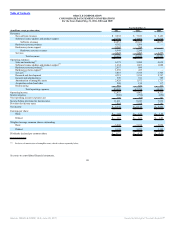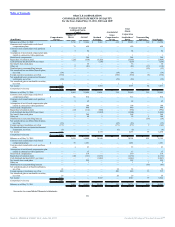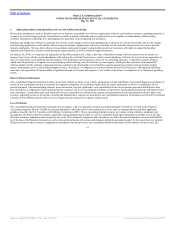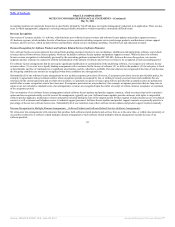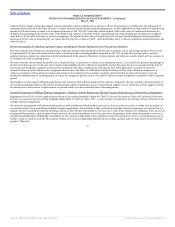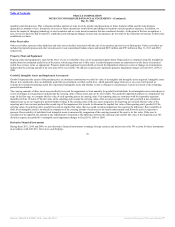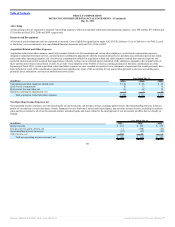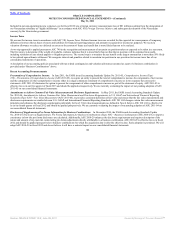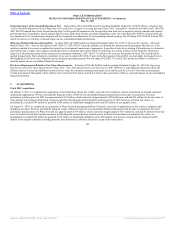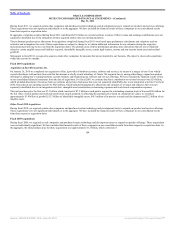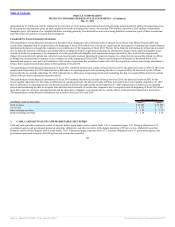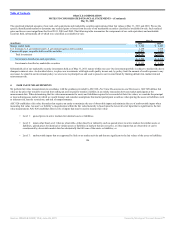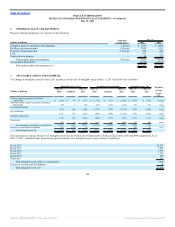Oracle 2010 Annual Report Download - page 102
Download and view the complete annual report
Please find page 102 of the 2010 Oracle annual report below. You can navigate through the pages in the report by either clicking on the pages listed below, or by using the keyword search tool below to find specific information within the annual report.
Table of Contents
ORACLE CORPORATION
NOTES TO CONSOLIDATED FINANCIAL STATEMENTS—(Continued)
May 31, 2011
measurement period. Subsequent to the measurement period or our final determination of the tax allowance’s or contingency’s estimated value, whichever comes
first, changes to these uncertain tax positions and tax related valuation allowances will affect our provision for income taxes in our consolidated statement of
operations and could have a material impact on our results of operations and financial position.
Marketable and Non-Marketable Securities
In accordance with ASC 320, Investments—Debt and Equity Securities, and based on our intentions regarding these instruments, we classify substantially all of
our marketable debt and equity securities as available-for-sale. Marketable debt and equity securities are reported at fair value, with all unrealized gains (losses)
reflected net of tax in stockholders’ equity. If we determine that an investment has an other than temporary decline in fair value, we recognize the investment loss
in non-operating income (expense), net in the accompanying consolidated statements of operations. We periodically evaluate our investments to determine if
impairment charges are required.
We hold investments in certain non-marketable equity securities in which we do not have a controlling interest or significant influence. These equity securities
are recorded at cost and included in other assets in the accompanying consolidated balance sheets. If based on the terms of our ownership of these
non-marketable securities we determine that we exercise significant influence on the entity to which these non-marketable securities relate, we apply the
requirements of ASC 323, Investments—Equity Method and Joint Ventures to account for such investments. Our non-marketable securities are subject to periodic
impairment reviews.
Fair Value of Financial Instruments
We apply the provisions of ASC 820, Fair Value Measurements and Disclosures, to our financial instruments that we are required to carry at fair value pursuant
to other accounting standards, including our investments in marketable debt and equity securities and our derivative financial instruments.
The additional disclosures regarding our fair value measurements are included in Note 4.
Allowances for Doubtful Accounts
We record allowances for doubtful accounts based upon a specific review of all significant outstanding invoices. For those invoices not specifically reviewed,
provisions are provided at differing rates, based upon the age of the receivable, the collection history associated with the geographic region that the receivable
was recorded in and current economic trends. We write-off a receivable and charge it against its recorded allowance when we have exhausted our collection
efforts without success.
Concentrations of Credit Risk
Financial instruments that are potentially subject to concentrations of credit risk consist primarily of cash and cash equivalents, marketable securities and trade
receivables. Our cash and cash equivalents are generally held with a number of large, diverse financial institutions worldwide to reduce the amount of exposure
to any single financial institution. Investment policies have been implemented that limit purchases of marketable debt securities to investment grade securities.
We generally do not require collateral to secure accounts receivable. The risk with respect to trade receivables is mitigated by credit evaluations we perform on
our customers, the short duration of our payment terms for the significant majority of our customer contracts and by the diversification of our customer base. No
single customer accounted for 10% or more of our total revenues in fiscal 2011, 2010 or 2009.
Inventories
Inventories are stated at the lower of cost or market value. Cost is computed using standard cost, which approximates actual cost, on a first-in, first-out basis. We
evaluate our ending inventories for estimated excess
98
Source: ORACLE CORP, 10-K, June 28, 2011 Powered by Morningstar® Document Research℠


